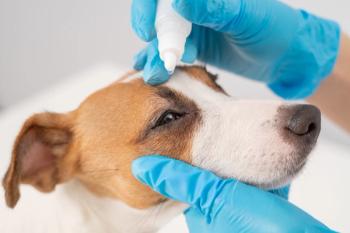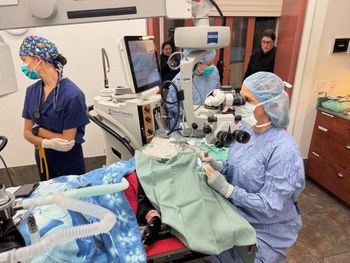
Equine corneal transplants' success rate growing
Treatment of equine eye diseases, especially through surgery, has made dramatic strides in the last 25 years. As late as the mid-1980s, many veterinarians expected to fail when treating horses' eyes in the mistaken belief that they heal poorly, one expert recalls.
Treatment of equine eye diseases, especially through surgery, has made dramatic strides in the last 25 years. As late as the mid-1980s, many veterinarians expected to fail when treating horses' eyes in the mistaken belief that they heal poorly, one expert recalls.
Actually, a horse's eye heals well from surgery, says Dennis Brooks, DVM, PhD, Dipl. ACVO, who with his colleagues has performed 236 equine corneal transplants since 1995 at the University of Florida's College of Veterinary Medicine, with a high success rate. "It just took us time to learn how to help it heal," he says.
Photo 1: A deep stromal abscess is present to cause severe uveitis.
Corneal transplantation for horses may be performed for optical, therapeutic, tectonic and cosmetic reasons, Brooks says. "Optical transplants restore or improve vision in cases of corneal edema. Therapeutic grafts attempt to control medically refractory corneal disease by removing necrotic and infected tissue. Tectonic grafts are done to preserve or restore the structural integrity of the eye when corneal tissue is missing and cosmetic grafts improve the appearance of the eye without necessarily improving vision."
The successful transplants by Brooks and colleagues were mostly for therapeutic and tectonic reasons. "Initially we did it, not just because we wanted to do that surgery, but because we had no choice," Brooks says.
The equine cornea is the anterior transparent portion of the fibrous tissue of the eye that supports the intraocular contents and transmits and refracts light. With disease, such as fungal infection, neoplasm, ulcers and/or infection due to laceration, its integrity and function may be compromised.
"Indications for surgical intervention include progression of corneal melting, increasing depth of an ulcer, persistence or progression of iridocyclitis despite appropriate medical therapy, posterior corneal location of a stromal abscess, stromal abscess rupture through the Descemet's membrane and suspicion of a corneal foreign body," explains Heidi Denis, DVM, Dipl. ACVO with Animal Eye Associates in Maitland, Fla.
Photo 2: The superficial cornea is elevated to expose the abscess, the abscess removed and the missing tissue replaced with split-thickness cornea in the posterior lamellar keratoplasty (PLK) procedure. This image shows corneal scarring one month postoperatively.
"Two basic surgical procedures have been described for the horse: penetrating keratoplasty (PK) for full-thickness stromal abscesses or ulcer/iris prolapses, and a split-thickness form of PK, the posterior lamellar keratoplasty (PLK), for deep stromal corneal abscesses (DSA) with a clear overlying anterior stroma," Brooks explains.
"A third type of split-thickness PK procedure, the deep lamellar endothelial keratoplasty (DLEK), has been used recently for DSA in the horse where the superficial cornea may be vascularized but is otherwise normal," Brooks says, pointing out that all three procedures have good visual outcomes, although partial graft rejection and scar formation are unavoidable.
Photo 3: Little scarring is present one year postoperatively.
Both fresh and frozen grafts are used in horses, though fresh ones "maximize endothelial cell preservation, minimizing post-operative corneal opacity," Brooks says. Frozen cornea may be damaged by changes in pH, osmolality, solute concentration and by ice-crystal formation. Though this damage may occur to tissue, it may be stored for up to six months and used satisfactorily. Because fresh grafts are not often available, success in horses is still quite good with frozen cornea.
For all transplant methods there is a high success rate, good visual outcome in 75 percent to 90 percent of cases and shorter treatment times than without surgery. Unfortunately, no matter how successful, all corneal transplants in horses vascularize, have some degree of opacity and are to some degree considered partially rejected.
Photo 4: A deep stromal abscess is causing severe pain and inflammation inside the eye.
The procedures
Penetrating keratoplasty involves full-thickness removal and replacement of a portion of the cornea. Once healing is complete, usually within 50 days, the visual outcome is greater than 75 percent for PK-treated horse eyes. "PK suffers from the inherent problem of creating a vertical stromal wound that requires surface corneal sutures," Brooks explains.
The procedure produces a stroma that "never develops the structural integrity and strength of the normal corneal tissue. A concern is that the PK graft epithelium often sloughs, leaving the graft open to infection. Besides graft failure, other complications include aqueous leakage from wound dehiscence/suture microleaks, focal nonprogressive cataract formation, hyphema and lens capsule rupture intraoperatively.
Photo 5: The abscess was removed by penetrating keratoplasty.
Both PLK and DLEK are useful especially in resolving deep stromal abscesses (DSA) with anterior chamber fungal invasion. With both procedures, the poster stroma and endothelium containing the abscess are surgically removed. "The basis of these split-thickness/lamellar surgeries is to replace only the diseased portion of the cornea, leaving the normal tissue intact, to do the least amount of resection for the greatest amount of benefit," says Brooks.
"PLK is recommended for deep stromal abscesses in the central cornea that are 8 mm or less and have a clear-overlying anterior stroma," Brooks explains. Abscesses larger than 8 mm may be more commonly associated with complications. This corneal transplant procedure is "associated with a shorter surgery and treatment time than the PK," Brooks notes.
"PLK removes infectious organisms, necrotic stroma and the metabolites of degenerating leukocytes while preserving the overlying stroma and epithelium," Denis explains. Complications of PLK include superficial suture abscesses, suture incision leaks, flap ulcers, graft failure requiring surgical repair or replacement, flap edema and Descemet's membrane retraction from the graft. The visual outcome for PLK is greater than 90 percent.
Photo 6: A deep stromal abscess is present under the red vascular pattern.
DLEK is recommended for DSA in the peripheral cornea that are 6 mm or less and have a clear overlying anterior stroma. As with PLK, larger abscesses may be associated with complications. This procedure avoids superficial incisions and suturing of the central cornea.
DLEK transfers healthy endothelium while preserving the corneal surface integrity. A fully intact epithelium with no corneal sutures is present postoperatively.
Though similar to PLK, DLEK is associated with a shorter surgery and treatment time than PK. Complications include ulcers near the incision, suture incision leaks, incision edema, graft failure requiring surgical repair, graft misplacement and focal nonprogressive cataract formation. The visual outcome is greater than 90 percent.
Room for improvement
Though the visual outcomes with all corneal transplant procedures in horses are successful, "they still are evolving," Brooks explains. Partial graft rejection and scar formation seem unavoidable. Improved technique with specialized surgical corneal forceps and scissors, and new pharmacologic approaches to infection and graft rejection, "could technically improve the transplant surgical procedures," Brooks suggests.
"My work is really just the beginning," Brooks says. "We've got more research, which we will start this summer to try to continue to figure out how to help the horse eye heal." In the past, when veterinarians treated horses' eye problems, 50 percent of the time they had to remove or enucleate the eye. "Fifty percent!" Brooks exclaims. "At the University of Florida, today, we hardly ever have to do an enucleation, because most of the time we figure out how to treat the condition either medically or surgically.
Photo 7: The deep lamellar keratoplasty (DLEK) procedure was used to remove only the deep, diseased tissue and replace it with half-thickness donor cornea.
"We need to educate other practitioners — which this article will help to do — to understand that the horse's eye heals well. It's just that we vets have had to learn, and are learning how to help it heal, rather than slow the healing process. I'm never satisfied. I didn't accept the idea, the veterinary dogma of the recent past, that the horse eye heals poorly," Brooks says.
"At the University of Florida, our team decided to collect data, to do projects to learn how to help the eye heal, and the corneal transplantation is the result. Before we started doing transplants, we really didn't understand some of these diseases."
The main reason the group did corneal transplants was for stromal abscesses, which are seen frequently. "Before we started doing surgery, we didn't get most of those better. If we got 50 percent of them better, I'd be surprised," Brooks explains. "For one thing, we didn't know what was causing them. Because we didn't know the cause, we didn't know how to treat them. Most of the time we were treating the wrong disease."
In 1998, Brooks and colleagues at the University of Florida decided that if they had to treat a horse the way it had been treated in the past, it was not going to get better.
"I told the owners that we need to do surgery on these and try and figure out how to treat them better," says Brooks. "They did it. It worked. They learned about the cause, which in the case of most stromal abscesses was fungal infection. As they started doing these PKs, they unfortunately removed the normal tissue as well. So then they began to do PLKs and DLEKs, leaving the normal tissue, which speeds up healing, and removing only the damaged part.
"So if we're able to do the PLK or DLEK, the healing rate is dramatically faster compared to the PK," Brooks says. The success rate is greater than 90 percent.
"Because veterinarians are doing corneal transplants in infected cornea, with blood vessels, they're having 100 percent rejection of the graft, which means it doesn't stay clear. So if I put in a 6 mm diameter corneal transplant in a horse, if everything works perfectly, I'm going to get a 6 mm scar," Brooks explains.
"In the past, we were removing the eyes. With time, within about six months to a year, the 6 mm scar pretty much disappears, so the eyes were quite well healed. Regardless of the 'rejection,' the horses still are able to see.
"However, I'm not satisfied," Brooks says.
So research begins this summer to determine how to stop rejection. The only limits are time and grant funding.
There's room for significant improvement, Brooks says. Veterinary ophthalmologists are doing mostly low-technology surgery, he says. They have operating microscopes, but not all the equipment that physicians use for human corneal transplant surgeries.
"If we get a little better technology, that'll help," says Brooks. "Better pharmacology, I think, will help. We need better drugs in order to help prevent the rejection."
Rejection "probably is due to some chemicals (e.g., cytokines) being released in the tissue, and we've got to find out what they are. If so, we can turn them off, and then we'll be able to improve our results, no question," Brooks believes.
Physicians sometimes operate on patients who have eye diseases similar to the horse. "In human ophthalmology terms, all the cases that we do in horses are considered at high risk for rejection. There are blood vessels there," Brooks explains.
The difference? Physicians often perform a second surgery to remove scar tissue. Veterinarians don't have that option with equine patients.
"We veterinarians get one shot to help these horses. But, even with the scarring, some more than others, the horses can see, and obviously better than before or with no eyes. A lot better — dramatically better," Brooks says.
Ed Kane, PhD, is a Seattle author, researcher and consultant in animal nutrition, physiology and veterinary medicine, with a background in horses, pets and livestock.
Newsletter
From exam room tips to practice management insights, get trusted veterinary news delivered straight to your inbox—subscribe to dvm360.




